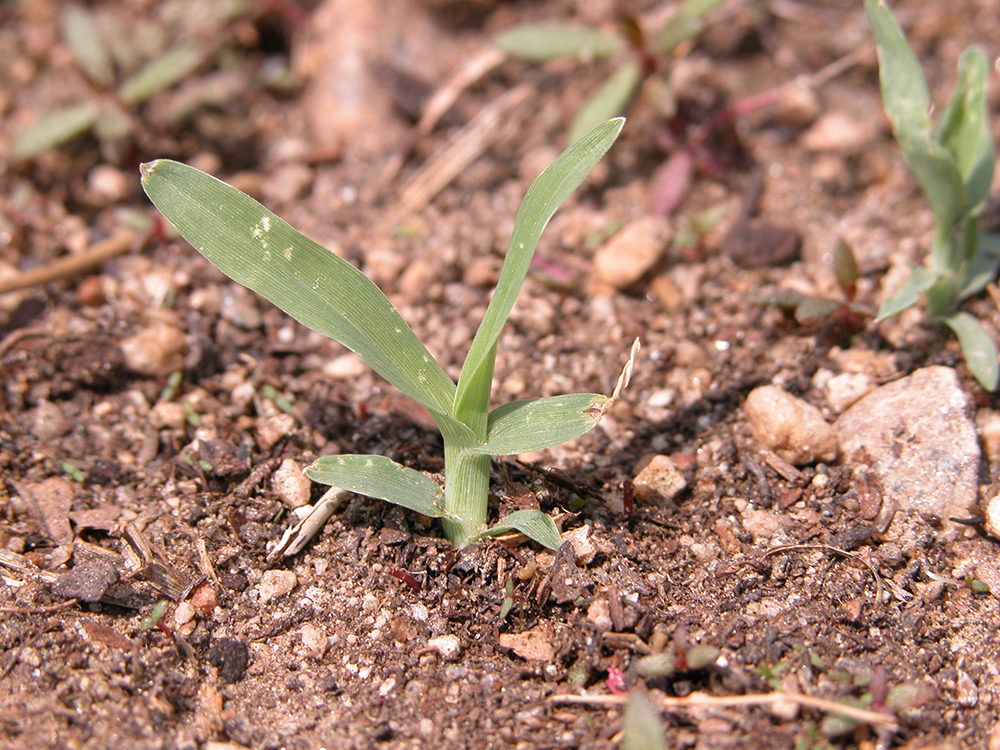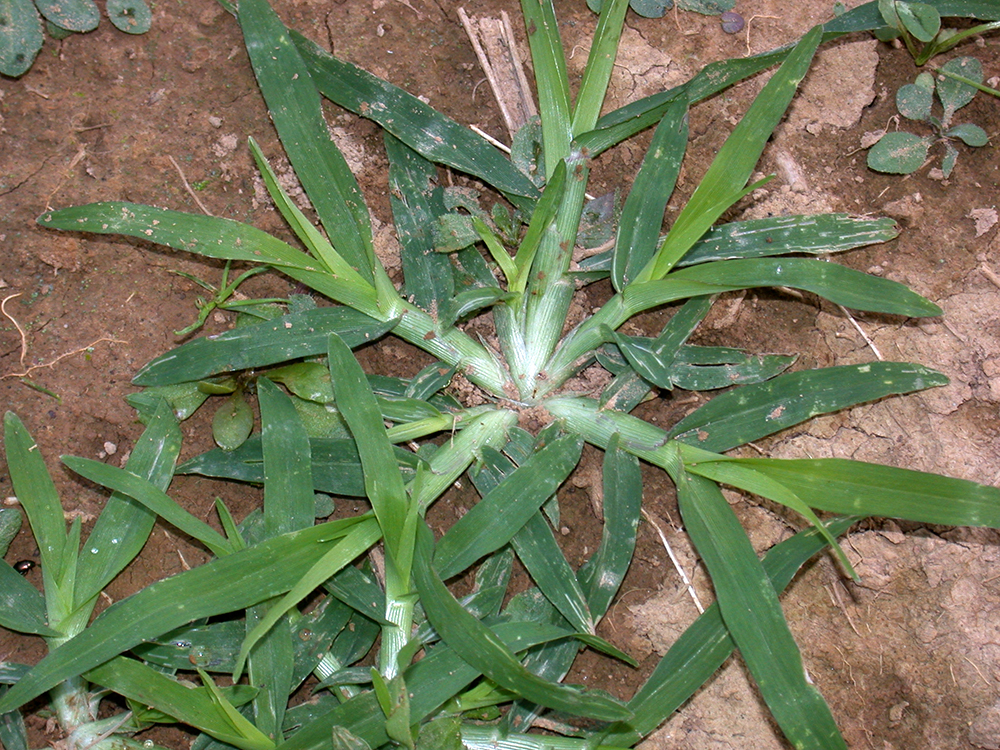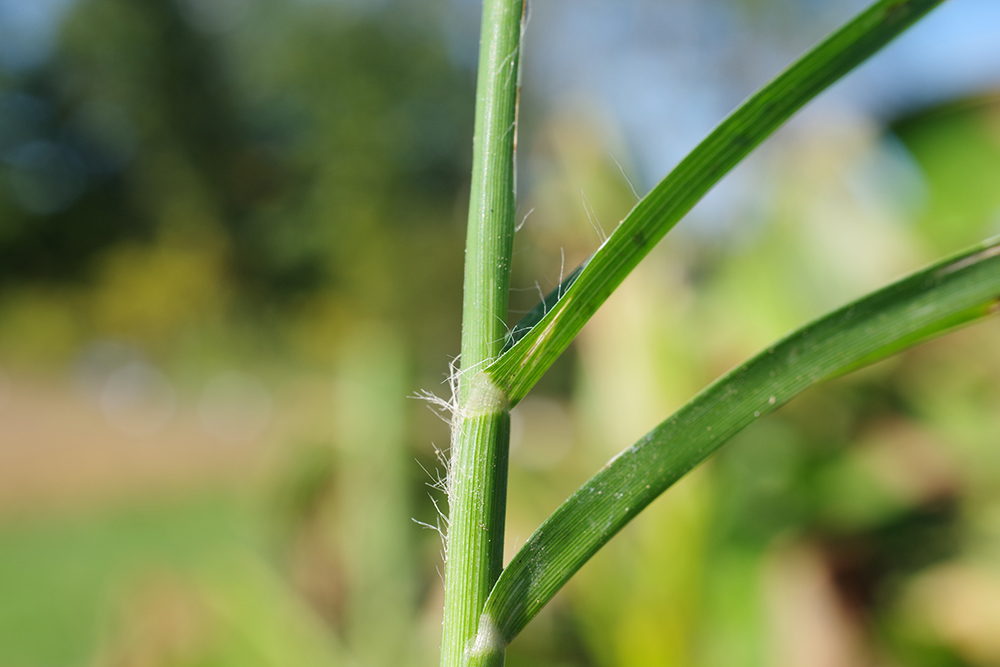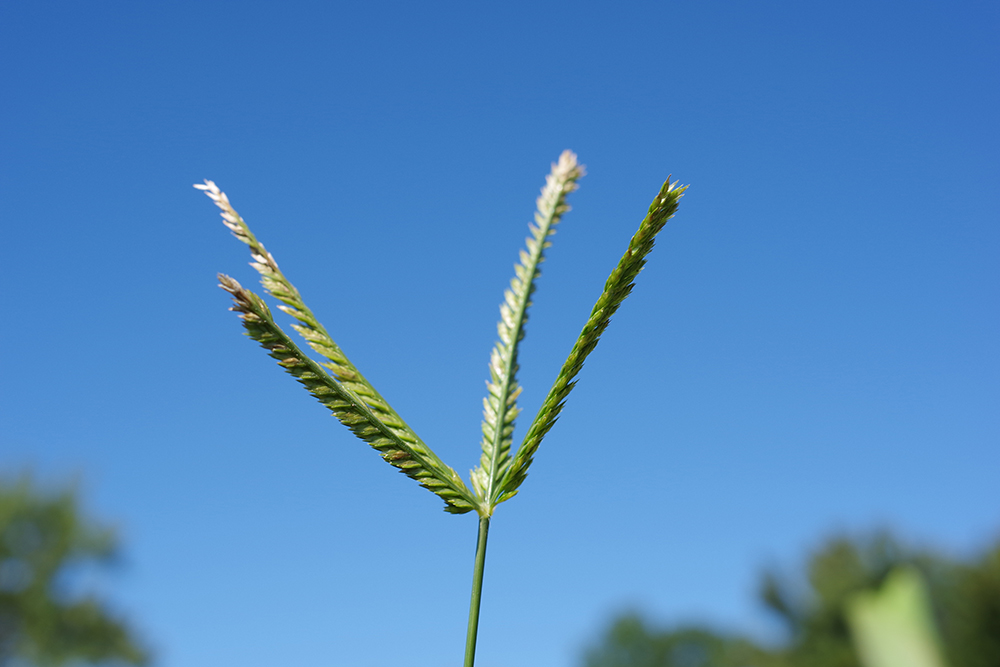Other common names: wiregrass, yard grass, crowfoot grass, crows foot grass, silver crabgrass, bullgrass, white crabgrass, Indian goosegrass




Eleusine indica (L.) Gaertn.
Identification of Goosegrass
Family: Grass family, Poaceae
Habit: semi-prostrate summer annual grass
Description: The seedling is folded in the bud and its first leaf opens parallel to the ground. The collar region is broad, white and lightly hairy, lacks auricles and has a small (less than 0.04 inch long), membranous, uneven, centrally notched ligule. Blades are 0.8–1.8 inches long by 0.1–0.2 inch wide, light green, smooth and distinctly veined. Leaf sheaths are smooth and light green to white at the base. Mature plants form a rosette, with sometimes erect but typically prostrate stems. Stems have branches and nodes; they can reach 28 inches in height. Blades are 2–8 inches long by 0.1–0.3 inch wide, occasionally hairy on blade surfaces and rough-edged. Sheaths are smooth, light green to white at the base and hairy near the collar region. Ligules and collar regions are similar to those of seedlings. The root system is fibrous. The multiple inflorescences are more upright than the leaves. Each stalk has 1–13 spikes radiating from the end. Spikes are 1.6–6 inches long by 0.1–0.3 inch wide. Spikelets are arranged on the spikes in two rows; they each have 3–6 fertile flowers. Flowers are 0.1–0.3 inch long; each contains one dark brown, 0.04–0.07 inch-long seed enclosed in white to light-tan chaff. Like all grasses, the apparent seed is covered by a thin, tight layer of fruit tissue.
Similar species: Crabgrass (Digitaria) species have the same mat-forming rosette habit but can be distinguished from goosegrass by their leaves being rolled in the bud. Orchardgrass (Dactylis glomerata L.) is folded in the bud but can be distinguished by its long (0.2–0.3 inch) ligule and panicle-like inflorescence.
Management of Goosegrass
Since goosegrass seeds die out of the soil relatively quickly, rotation with perennial sod crops should reduce populations substantially. Winter grains are well established by the time goosegrass germinates and will compete well against the weed. Since seed survival in the soil is limited and seedlings only establish from seeds close to the soil surface, moldboard plow the spring following heavy seed production events. Relatively few seeds will survive to find their way back to the soil surface during subsequent tillage events.
Goosegrass has a long period of emergence throughout the Southeast, and late emerging plants of this fast growing weed can compete with the crop and build the seed bank. However, its germination is strongly promoted by tillage. Thus, before planting relatively slow growing summer crops on goosegrass infested land, use a fallow period with shallow tillage at intervals to deplete the surface seed bank before planting. Tine weed row crops with increasing aggressiveness as the crop establishes, and do the last inter-row cultivation as late as possible. Cultivate shallowly close to the crop rows with sharp, flat pitched half sweeps or vegetable knives to sever shoots from the roots.
In vegetable crops, hoe out plants missed by cultivation before they flower, preferably when the weather will assure rapid drying so that the plants do not reroot. Rogue out large escapes to prevent seed production. Straw mulch at 2.7 tons per acre has been shown to reduce goosegrass emergence by 90% relative to bare soil, and heavier rates would be even more effective.
In all cropping systems, avoid soil compaction and over-fertilization, as both are likely to promote goosegrass.
Ecology of Goosegrass
Origin and distribution: Goosegrass probably originated in south or east Asia.Its present distribution includes the Middle East; south, southeast and east Asia; sub-Saharan Africa; New Guinea; Australia; New Zealand; and North, Central and South America. It occurs in most of the United States except for parts of the Pacific Northwest and northern Rocky Mountains. It also occurs in Hawaii and southern Quebec and Ontario. It is most common in the southeastern and central states.
Seed weight: Mean population seed weight ranges from 0.4–0.5 mg.
Dormancy and germination: Freshly matured seeds of goosegrass are dormant. Fluctuating temperatures, light, nitrate, chilling, scarification and aging all promote germination. Germination is negligible at 68°F or lower. Few fresh seeds will germinate at constant temperatures of 68–104°F, but most will germinate if daily temperatures fluctuate within this range by at least 18°F. Light increases germination at constant temperatures and at fluctuating temperatures. Nitrate also stimulates germination. About half of scarified seeds will germinate at a constant 86°F or 104°F but none at 122°F. Chilling wet seeds for 40 days or letting the seeds age for several months increases germination, and light is no longer needed to promote germination of seeds that have aged. Seeds germinate well at pH from 5 to 10 and in saline conditions, but the species cannot germinate under even moderate moisture stress.
Seed longevity: Studies of goosegrass seed survival in the soil differ, with some finding few seeds surviving beyond three years, whereas others have found moderate death rates with some seeds remaining as long as nine or 10 years. Annual mortality rate computed from a study in Mississippi was 44%. However, an estimated 82% of seeds survived one year buried under turf. The species thus forms short to moderately long-lived seed banks, with the variation probably due to differences in soil, climate and characteristics of the local population.
Season of emergence: In the mid-South, goosegrass emerges from April through August. Seedlings emerged primarily in late spring to early summer in a Mediterranean climate similar to that of California.
Emergence depth: Goosegrass emerges best at the soil surface or from the top 0.8 inch, only a few seeds can emerge from 2 inches, and none can emerge from deeper than 2.8 inches.
Photosynthetic pathway: C4
Sensitivity to frost: Goosegrass cannot tolerate more than brief exposure to subfreezing temperatures.
Drought tolerance: It can tolerate moderate periods of hot, dry conditions if well rooted, but it is not truly drought tolerant.
Mycorrhiza: Goosegrass is mycorrhizal.
Response to fertility: Goosegrass showed a positive growth response to N application rates up to 206 pounds per acre, whereas in the same experiment, rice showed no growth response above 138 pounds per acre. Nevertheless, goosegrass was less competitive against upland rice as N application increased. N, P and K were applied at rates of 45, 45 and 36 pounds per acre alone or in combination to a nutrient poor soil. N alone more than doubled the growth of a goosegrass dominated weed community. P alone substantially increased weed cover but had little effect on weed dry weight unless N was also applied. K only increased weed dry weight if N and P were also applied. Goosegrass is most commonly observed on soils with relatively high P, K, Ca and Mg. Thus, goosegrass appears to be highly responsive to N and to be generally favored by high fertility conditions. High pH also benefits goosegrass, and it can tolerate pH of 8.6.
Soil physical requirements: Goosegrass occurs on many types of soil. Although soil compaction decreases root growth moderately, it has little effect on shoot growth, and the species is highly competitive in compacted soil. Although the species is more common on well drained soils, it tolerates wet soils and grows well under poorly aerated conditions. It is moderately salt tolerant and excretes excess salt through special glands.
Response to shade: Shade substantially reduces growth. Plants grow more upright when shaded.
Sensitivity to disturbance: Goosegrass tolerates traffic well and responds to it by developing shorter, wider leaves. The species is highly tolerant of soil contaminated with petroleum and heavy metals.
Time from emergence to flowering: Under favorable conditions, plants will flower in 30 days and shed seeds in 70 days. When planted in an experiment, plants began flowering at six weeks after planting, and the number of inflorescences per plant increased progressively over the next six weeks.
Pollination: Plants readily self-pollinate, and genetic analysis indicates that selfing is common but that cross-pollination also occurs.
Reproduction: A single plant can produce up to 140,000 seeds in favorable conditions, but average seed production in low competition conditions is more typically 40,000–50,000 seeds per plant. Plants growing in an oil palm plantation produced an average of 4,800 seeds per plant.
Dispersal: Seeds blow in the wind. They also disperse with mud on the feet of animals, shoes, motor vehicles and probably on machinery as well. Goosegrass seeds occur in manure and are dispersed when it is spread.
Common natural enemies: The leaf-spotting fungus Bipolaris setariae sometimes causes substantial damage.Palatability: Goosegrass has been occasionally grown for grain in parts of Africa and Asia, and it is also sometimes grown for hay. It is one of the two ancestors of the tetraploid crop finger millet (Eleusine coracana subsp. coracana).
Summary Table of Goosegrass Characteristics
| Goosegrass | ||||||||
|---|---|---|---|---|---|---|---|---|
| Growth habit | Seed weight (mg) | Seed dormancy at shedding | Factors breaking dormancy | Optimum temperature for germination (F) | Seed mortality in untilled soil (%/year) | Seed mortality in tilled soil (%/year) | Typical emergence season | Optimum emergence depth (inches) |
| prostrate | 0.4–0.5 | Yes | cms, li, at, ni | 86/68 to 104/86 | 18–44 | na | spring to summer | 0–0.8 |
| Photosynthesis type | Frost tolerance | Drought tolerance | Mycorrhiza | Response to nutrients | Emergence to flowering (weeks) | Flowering to viable seed (weeks) | Pollination | Typical & high seed production (seeds per plant) |
| C4 | low | moderate | yes | high | 5 | 5 | self, can cross | 5,000 & 50,000 |
Table Key
General: The designation “–” signifies that data is not available or the category is not applicable.
Growth habit: A two-word description; the first word indicates relative height (tall, medium, short, prostrate) and second word indicates degree of branching (erect, branching, vining).
Seed weight: Range of reported values in units of “mg per seed.”
Seed dormancy at shedding: “Yes” if most seeds are dormant when shed, “Variable” if dormancy is highly variable, “No” if most seeds are not dormant.
Factors breaking dormancy: The principle factors that are reported to break dormancy and facilitate germination. The order of listing does not imply order of importance. Abbreviations are:
scd = seed coat deterioration
cms = a period subjected to cold, moist soil conditions
wst = warm soil temperatures
li = light
at = alternating day-night temperatures
ni = nitrates
Optimum temperature range for germination: Temperature (Fahrenheit) range that provides for optimum germination of non-dormant seeds. Germination at lower percentages can occur outside of this range. The dash refers to temperature range, and the slash refers to alternating day/night temperature amplitudes.
Seed mortality in untilled soil: Range of mortality estimates (percentage of seed mortality in one year) for buried seeds in untilled soil. Values were chosen where possible for seeds placed at depths below the emergence depth for the species and left undisturbed until assessment. Mortality primarily represents seed deterioration in soil.
Seed mortality in tilled soil: Range of mortality estimates (percentage of seed mortality in one year) for seeds in tilled soil. Values were chosen for seeds placed within the tillage depth and subjected to at least annual tillage events. Seed losses are the result of dormancy-breaking cues induced by tillage, germination and deterioration of un-germinated seeds.
Typical emergence season: Time of year when most emergence occurs in the typical regions of occurrence for each weed. Some emergence may occur outside of this range.
Optimum emergence depth: Soil depths (in inches below the soil surface) from which most seedlings emerge. Lower rates of emergence usually will occur at depths just above or just below this range.
Photosynthesis type: Codes “C3” or “C4” refer to the metabolic pathway for fixing carbon dioxide during photosynthesis. Generally, C3 plants function better in cooler seasons or environments and C4 plants function better in warmer seasons or environments.
Frost tolerance: Relative tolerance of plants to freezing temperatures (high, moderate, low).
Drought tolerance: Relative tolerance of plants to drought (high, moderate, low).
Mycorrhiza: Presence of mycorrhizal fungi. “Yes” if present; “no” if documented not to be present, “unclear” if there are reports of both presence and absence; “variable” if the weed can function either with or without, depending on the soil environment.
Response to nutrients: Relative plant growth response to the nutrient content of soil, primarily N, P, K (high, moderate, low).
Emergence to flowering: Length of time (weeks) after emergence for plants to begin flowering given typical emergence in the region of occurrence. For species emerging in fall, “emergence to flowering” means time from resumption of growth in spring to first flowering.
Flowering to viable seed: Length of time (weeks) after flowering for seeds to become viable.
Pollination: “Self” refers to species that exclusively self-pollinate, “cross” refers to species that exclusively cross-pollinate, “self, can cross” refer to species that primarily self-pollinate, but also cross-pollinate at a low rate, and “both” refers to species that both self-pollinate and cross-pollinate at relatively similar rates.
Typical and high seed production potential: The first value is seed production (seeds per plant) under typical conditions with crop and weed competition. The second value, high seed production, refers to conditions of low density without crop competition. Numbers are rounded off to a magnitude that is representative of often highly variable reported values.
Further Reading
Ampong-Nyarko, K. and S.K. De Datta. 1993. Effect of nitrogen application on growth, nitrogen use efficiency and rice-weed interaction. Weed Research 33: 269–276.
Arrieta, C., P. Busey and S.H. Daroub. 2009. Goosegrass and bermudagrass competition under compaction. Agronomy Journal 101: 11–16.
Holm, L.G., D.L. Plucknett, J.V. Pancho and J.P. Herberger. 1977. The World's Worst Weeds: Distribution and Biology. The University Press of Hawaii: Honolulu.

